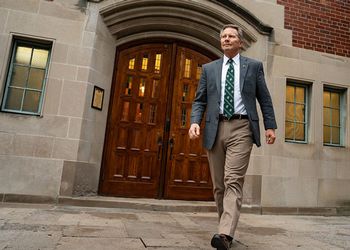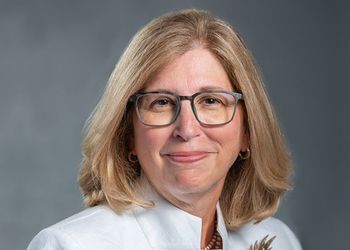Feature: New Science Building Promises Connectivity

With its new Science Building, MSU seeks breakthroughs through 'connectivity' in campus research.
The last time MSU put physics and biology researchers in the same building, something wonderful happened - something totally unprecedented and unpredictable. Cisplatin. Arguably the most important cancer drug discovered to date, cisplatin, along with its analog, carboplatin, have saved hundreds of thousands of lives. And brought more than $160 million in royalty revenues to MSU. Now, the Biology Research Center -- the small, unspectacular, and inexpensive building in which cisplatin was discovered -- is gone. It has been torn down to make room for a huge, $93 million science facility that will dominate the south campus skyline when completed early in 2002.
Like its comparatively tiny predecessor, the new Biomedical and Physical Sciences Center (BPSC) will have biologists and physicists under one roof. It will house the Departments of Microbiology, Physiology, and Physics and Astronomy, as well as the Center for Microbial Ecology and the Center for Sensor Materials. In addition, it will connect to the Chemistry Building and to the Biochemistry Building and become the hub of the largest science complex on campus.
At the formal groundbreaking for BPSC, the governor of Michigan, the president of MSU, other top leaders and four medical/science students predicted great benefits. They said MSU will be putting high-quality faculty and students from complementary areas of science in a user friendly, state-of-the-art facility. Through such a match, they predicted, MSU, the state, and society at large will surely reap a golden harvest of science alumni and discoveries that will help to shape the upcoming millennium. Rewards as great as cisplatin? That’s a very high bar. Still, one never knows what might happen when the right people are in the right place at the right time and serendipity is at work.
THE CISPLATIN STORY
That’s what came about in 1962 when Dr. Barnett Rosenberg arrived on campus as cofounder of the Department of Biophysics and set up his laboratory in the brand new Biology Research Center. An idea he brought with him from New York University was to study the effects of an electrical current on bacteria growing in a liquid medium. When he set up the experiment, he was amazed to observe that the bacteria were growing to an enormous size without dividing. Further study revealed that the phenomenon was caused not by the electric current but by a compound formed from platinum electrodes reacting with the liquid medium. The compound was identified by chemistry graduate student Thomas Krigas and later shown to be cisplatin.
Thinking a compound that inhibited cell division might also have anticancer properties, Rosenberg and biology technician Loretta Van Camp checked to see what cisplatin would do to tumors in mice. When those studies showed that the tumors virtually disappeared, the National Institutes of Health carried out extensive human testing. In 1978, the drug was approved by the Food and Drug Administration. Out of the basic research of a physicist, a chemist and a biologist, cisplatin was born.
THE CONNECTIVITY FACTOR
What are the chances of a similar serendipitous discovery in the future at MSU? They’re low, but thanks to the faculty and architects who designed it, the BPSC has advantages that improve the odds in favor of serendipity happening for the right people in the right place. The main asset is both physical and intangible. The planners call it 'connectivity.' The physical part is obvious because the BPSC will connect the existing Chemistry Building to the existing Biochemistry Building, creating a major science complex as well as a single building. The main and most spectacular connector will be a four-story atrium corridor. Measuring 128 feet long by 27 feet wide, it will be the major path for faculty and students moving between the Chemistry and Biochemistry Buildings. It will also provide access between the seven-story laboratory wing to the west and the four-story classroom and office wing to the east. The atrium will be attractively furnished with lounges and conversation areas designed to maximize the possibility of informal, fortuitous encounters. This effect will be enhanced by a spacious, well-stocked science library that will open onto the atrium. It will serve not only the scientists and students in the three-building complex but also those in the several plant-science buildings across Wilson Road.
At the south end of the atrium, passers by will be drawn to a television screen showing constantly updated views of the stars -- but not the ones directly overhead. These will be Southern Hemisphere stars being observed by MSU astronomers from the Andes Mountains of Chile. The observatory is now under construction by a university consortium in the Andes Mountains of Chile. The intangible asset springs from physical connectivity heightening people connectivity. The idea is to optimize the possibility that contacts among people coming together from a variety of knowledge bases and perspectives will spark new ideas and foster collaboration. 'That’s important,' says planning coordinator John W. Judy, retired associate dean of veterinary medicine.
He wishes he’d had ready access to physicists some years ago when he was doing research on artery disease because he needed to learn more about fluid-flow dynamics, a physics specialty. 'With the library and the eating areas and atrium arranged as they are, people from the five departments will converge' he explains. 'A lot of them have joint research projects now. And I’m sure we’ll be seeing more. Maybe someday, the departments will be more integrated.'
Provost Lou Anna Simon agrees wholeheartedly. 'That kind of human interaction is extraordinarily important to science,' she said. 'This building will permit many people from different backgrounds to bump into one another, have casual but significant hallway conversations – the sharing of ideas about issues and concerns that are now confined to conversations within disciplines or divisions.
'As a result, the future will be differently defined. It’s hard for me to imagine the specifics, but I know these interactions will be at the core of our success.'
Obviously, good research and teaching require more than connectivity – for example, Rosenberg emphasizes the importance of one person sitting alone and thinking. Still connectivity is considered a very positive feature. Many serious problems in health, the environment and other areas demand the concerted energy of different disciplines working in concert. Moreover, BPSC offers many other advantages for research and teaching.
BIGGEST AND BEST
The new building, which will be one of the largest structures on campus, is sorely needed and would be a major addition to MSU’s scientific capabilities even without the connectivity factor. This is readily apparent to anyone familiar with the buildings now inhabited by the departments that will be moving into BPSC. While these buildings are rich in scientific history (pioneer work in cyclotron design, infectious diseases, cancer/hormone relationships, and orthopedic surgery, for example), the faculty and students are handicapped by outmoded facilities.
Giltner Hall, home to the microbiology and physiology departments, was built in 1913 and has had six somewhat impromptu additions since then. Although some labs have been refurbished over the years and contain much modern equipment, the overall milieu is more reminiscent of the last turn of the century than of the one now beginning. The Physics-Astronomy Building went up in 1949 as MSU rushed to accommodate the great post-war enrollment.



